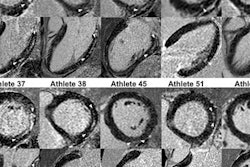In patients with hypertrophic cardiomyopathy, myocardial late gadolinium enhancement on contrast-enhanced MRI may be a risk factor for cardiac death, preliminary research suggests.
The study of 424 patients with hypertrophic cardiomyopathy who underwent contrast-enhanced 1.5-tesla MRI (Signa CV/i, GE Healthcare, Chalfont St. Giles, U.K.) over a six-year period showed that late gadolinium enhancement (LGE) involving 5% or more of left ventricular mass was an independent predictor of cardiac death or appropriate implantable cardioverter defibrillator (ICD) discharges.
"Myocardial late gadolinium enhancement on contrast-enhanced images may be a sign of intramyocardial fibrosis" said Dr. Ronen Rubinshtein, a fellow in cardiovascular disease at the Mayo Clinic in Rochester, MN. "We explored whether the presence and extent of LGE on MRI among these patients can predict ventricular arrhythmogenicity and decreased cardiac survival."
Rubinshtein presented the results at the American Heart Association (AHA) conference in New Orleans in November.
Of the 424 patients, 239 (56%) had late gadolinium enhancement ranging from 0.4% to 65% of the myocardium. "The most common location for late gadolinium enhancement -- in 73% of cases -- was the right ventricular insertion points," he said.
In 220 patients who underwent Holter electrocardiogram (ECG) during the same time period as MRI, the researchers compared the presence and amount of late gadolinium enhancement with the degree of ventricular ectopy.
Results showed that patients with positive LGE were more likely to have nonsustained ventricular tachycardia: 34 of 126 patients (27%), versus eight of 94 (8.5%) without positive LGE.
"They were also more likely to have a high number of ventricular beats: 700 ventricular extrasystoles in 24 hours, versus 460 in the nonpositive group," Rubinshtein said.
During a mean follow-up period of three years, five patients died from cardiac causes and four of 41 patients with ICDs received appropriate discharges. All nine patients had late gadolinium enhancement, and six of the nine had LGE that involved 5% or more of the left ventricular mass.
Univariate predictors of adverse outcomes among patients were late gadolinium enhancement, a history of atrial fibrillation, and the presence of nonsustained ventricular tachycardia on Holter ECG.
In multivariate analysis that adjusted for age, gender, morphologic and functional data, and comorbidities, late gadolinium enhancement involving 5% or more of left ventricular mass remained an independent predictor of cardiac death or appropriate ICD discharges (hazard risk = 9.6, p = 0.02).
"These findings are very preliminary. But if replicated, late gadolinium enhancement might be considered a major risk factor for cardiac death in patients with hypertrophic cardiomyopathy," Rubinshtein said.
By Charlene Laino
AuntMinnie.com contributing writer
December 18, 2008
Related Reading
Coronary artery spasm may trigger acute coronary syndrome, August 15, 2008
Global RV function on ECG-gated 64-slice MDCT compares well with MRI, July 4, 2008
CT angiography outperforms stress testing in diagnosing coronary artery disease, April 16, 2008
Tissue Doppler beats standard echo in predicting heart failure, April 11, 2008
Myocardial fibrosis tied to ventricular arrhythmias, April 11, 2008
Copyright © 2008 AuntMinnie.com


.fFmgij6Hin.png?auto=compress%2Cformat&fit=crop&h=100&q=70&w=100)





.fFmgij6Hin.png?auto=compress%2Cformat&fit=crop&h=167&q=70&w=250)











